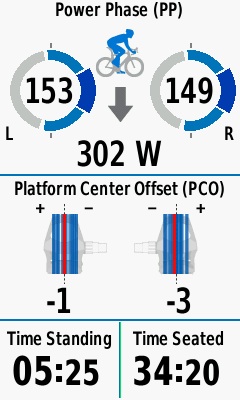Introducing Cycling Dynamics from Garmin® – revolutionary cycling metrics for Vector™ power meter
We're excited to announce Cycling Dynamics – revolutionary metrics on the dual-sensing Vector pedal-based power meter that provide feedback to cyclists on their position and pedal form. Cycling Dynamics’ initial advanced metrics include seated/standing position, Power Phase, and Platform Center Offset for a comprehensive picture of how cyclists ride their bikes. With Cycling Dynamics, cyclists, coaches, bike fitters, physical therapists and more can analyze individual data for precise prescriptive actions.
pedal-based power meter that provide feedback to cyclists on their position and pedal form. Cycling Dynamics’ initial advanced metrics include seated/standing position, Power Phase, and Platform Center Offset for a comprehensive picture of how cyclists ride their bikes. With Cycling Dynamics, cyclists, coaches, bike fitters, physical therapists and more can analyze individual data for precise prescriptive actions.
“There is no ‘one size fits all’ solution for improving cycling efficiency – bike fit, position effectiveness, and training techniques all need to be personalized,” said Dan Bartel, Garmin vice president of worldwide sales. “Cycling Dynamics’ in-depth metrics for form and riding style are intended to help save time and frustration during the typical trial and error stage of assessing weaknesses and determining best solutions so cyclists can ride longer, faster and more comfortably.”
Seated/Standing Position
Cyclists typically have a unique preference for position on the bike during climbs and sprints. With Cycling Dynamics, Vector instantaneously detects and flags riding position (seated or standing) during a ride by comparing forces applied to the pedals. Current position, summaries of how often and how long riders have been in the position, and power data can be displayed in real time.
Post-ride, users can upload their data to Garmin Connect to view each position, associated cadence and speed, compare time spent seated vs. standing, learn how a position affects power output, and analyze climbs and sprints. This data can be useful when determining position effectiveness, and identifying any tendencies to move positions during particular moments of a ride.
to view each position, associated cadence and speed, compare time spent seated vs. standing, learn how a position affects power output, and analyze climbs and sprints. This data can be useful when determining position effectiveness, and identifying any tendencies to move positions during particular moments of a ride.
Power Phase (PP)
The Cycling Dynamics Power Phase provides a valuable description of how a cyclist is currently producing power in a pedal stroke. Vector detects where the leg is generating positive torque in a pedal stroke, where the greatest concentration of positive torque is, at what angle these forces begin and end, and where the concentration of power is produced. The dual-sensing capabilities also allow cyclists to take their analysis one step further and see if there are differences between the left and right leg.
Platform Center Offset (PCO)
The Platform Center Offset measurement system allows Vector to identify how force is distributed across the pedal platform during the pedal stroke. Cyclists can view and evaluate where force is applied relative to the center of the pedal platform and what the PCO distribution is over a given period of time. Analysis of this data may assist in determining proper bike fit, and be helpful with rehabilitation and prevention of injury for cyclists.
Cycling Dynamics metrics will be available to dual-sensing Vector users via a software update in late 2014.
The post Introducing Cycling Dynamics from Garmin® – revolutionary cycling metrics for Vector™ power meter appeared first on Garmin Blog.
Sample Block Quote
Praesent vestibulum congue tellus at fringilla. Curabitur vitae semper sem, eu convallis est. Cras felis nunc commodo loremous convallis vitae interdum non nisl. Maecenas ac est sit amet augue pharetra convallis nec danos.
Sample Paragraph Text
Praesent vestibulum congue tellus at fringilla. Curabitur vitae semper sem, eu convallis est. Cras felis nunc commodo eu convallis vitae interdum non nisl. Maecenas ac est sit amet augue pharetra convallis nec danos dui.
Cras suscipit quam et turpis eleifend vitae malesuada magna congue. Damus id ullamcorper neque. Sed vitae mi a mi pretium aliquet ac sed elitos. Pellentesque nulla eros accumsan quis justo at tincidunt lobortis denimes loremous. Suspendisse vestibulum lectus in lectus volutpat, ut dapibus purus pulvinar. Vestibulum sit amet auctor ipsum.



